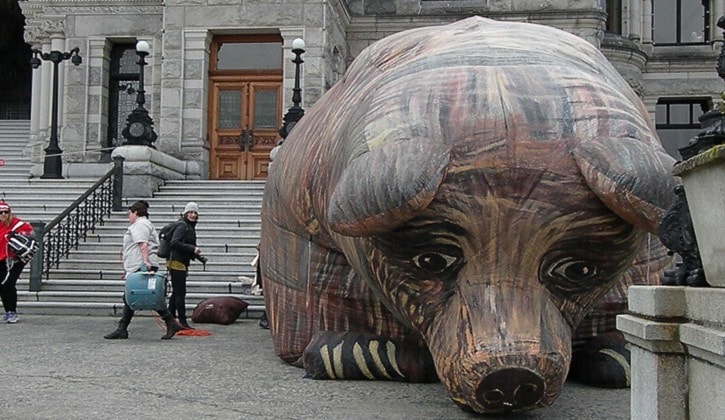The B.C. legislature attracts its share of fake news events, especially now during a pre-election sitting.
We had a couple of these staged protests last week. The Wilderness Committee hauled a giant inflatable plastic grizzly bear to the front steps and pumped it up to attract gullible TV coverage of their petition demanding an endangered species law.

No, B.C. grizzlies arenB��Ԫ������ַ�t endangered. ThatB��Ԫ������ַ�s an B��Ԫ������ַ�alternative fact.B��Ԫ������ַ� Their news release talked mostly about spotted owls, whose tiny northern fringe population extending into B.C. has been a fundraising favourite of professional tree-huggers for decades.
Sweeping logging bans south of the border didnB��Ԫ������ַ�t B��Ԫ������ַ�saveB��Ԫ������ַ� spotted owls in their actual home range. It just put forest companies out of business, which is the apparent intent of the Wilderness Committee. In Washington and Oregon, barred owls moved in and displaced their wimpier spotted owl cousins.
The other fake news protest was a more serious matter. An outfit calling itself the B.C. Health Coalition brought two B��Ԫ������ַ�survivorsB��Ԫ������ַ� of blood transfusions to warn of the danger posed by a B��Ԫ������ַ�pay-for-plasmaB��Ԫ������ַ� company that wants to expand in Canada.
One told a grim tale of being hit by a car while walking his dog in Victoria. He said transfusions saved his life, his friends donated blood on his behalf, and voluntary donations are at risk by the opening of a company called Canadian Plasma Resources, which gives out $25 gift cards for blood donations at its Saskatchewan clinic.
The other is a hemophiliac who received a virus-tainted transfusion in the 1980s. He claimed that current technologies donB��Ԫ������ַ�t catch new viruses, and somehow this new company will lead to the next tainted blood disaster.
Space does not permit listing everything thatB��Ԫ������ַ�s wrong with these arguments.
First, Canadian Blood Services collects enough volunteer blood and plasma to supply all the transfusions done in Canadian hospitals.
Canadian Blood Services can provide only enough plasma to meet about 17 per cent of demand for immune globulins, one of the protein treatments derived from large quantities of plasma. The rest of the plasma for these products comes from paid donors in the United States.
B��Ԫ������ַ�Drugs made from plasma donated by paid donors are just as safe as those made from plasma from volunteer donors,B��Ԫ������ַ� Canadian Blood Services states on its website.
Any suggestion that paid plasma donations reach trauma patients, or that highly refined products of donor plasma are unsafe, is false propaganda.
So what is the B.C. Health Coalition? ItB��Ԫ������ַ�s a front for union organizations around the province, and it typically stirs to life around election time. When it comes to the safety of medical products and procedures, whom should you believe: senior scientists at Health Canada, or the New Westminster and District Labour Council?
This recurring media stunt has nothing to do with plasma purity. It is about ideological purity, as determined by the labour movement operators who run this show, including former Hospital EmployeesB��Ԫ������ַ� Union executive and now NDP health critic Judy Darcy.
The real point of these misguided testimonials is to repel private manufacturers, in this case to the accidental benefit of U.S. producers.
I have been a regular Canadian Blood Services volunteer donor for more than 10 years, and IB��Ԫ������ַ�ve seen the changes to procedures as new threats like Zika virus have emerged. Every donation includes multiple test samples in addition to the bag of blood that goes for transfusions or processing into plasma and other components.
It would be great if enough people donated blood to provide everything. But thatB��Ԫ������ַ�s not the world we live in.
Tom Fletcher is B.C. legislature reporter and columnist for Black Press. Email: tfletcher@blackpress.ca Twitter: @tomfletcherbc



